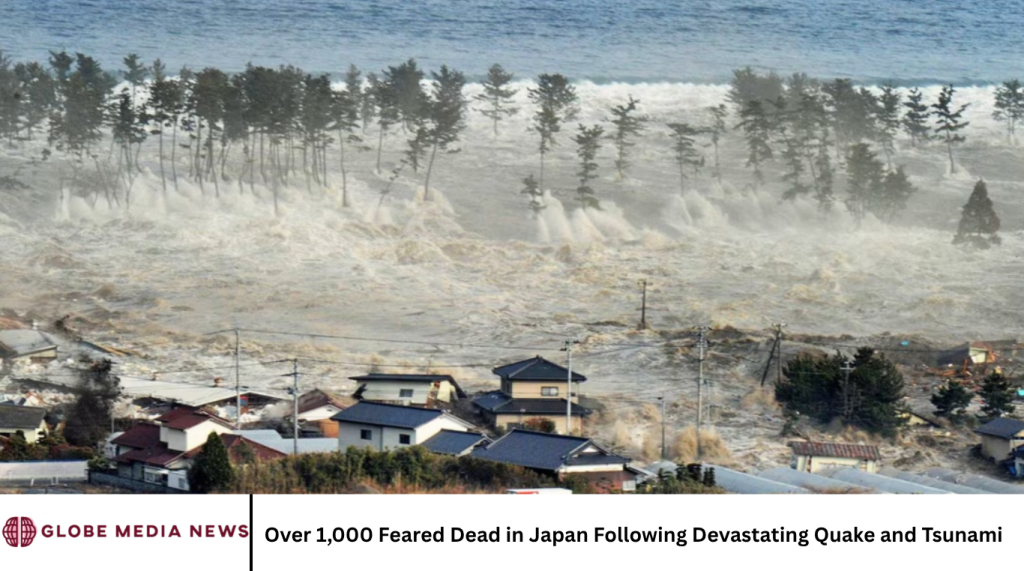A devastating earthquake and subsequent tsunami have struck Japan, leaving over 1,000 people feared dead. The disaster has caused widespread destruction, with entire towns submerged and critical infrastructure obliterated. Rescue operations are underway, but the scale of the catastrophe continues to unfold.
The Disaster Unfolds
On March 11, 2011, at 14:46 JST, a massive 9.0-magnitude undersea megathrust earthquake struck off the coast of Japan’s Tōhoku region. The earthquake triggered a powerful tsunami, with waves reaching heights of up to 40.5 meters in some areas. The combined effects of the quake and tsunami have led to catastrophic damage across multiple prefectures.
Impact on Affected Regions
Sendai, the capital of Miyagi Prefecture, has been among the hardest-hit areas. The tsunami inundated the city, sweeping away buildings, vehicles, and infrastructure. The airport was submerged, and fires broke out in several locations, exacerbating the destruction.
Iwate Prefecture has also suffered significant damage, with towns like Rikuzentakata and Miyako experiencing severe flooding and structural collapse. The mountainous terrain has hindered rescue efforts, making access to affected areas challenging
Chiba Prefecture, located to the east of Tokyo, reported casualties due to collapsed buildings and infrastructure failures. The capital city, Tokyo, experienced strong shaking, but the damage was less severe compared to the coastal regions.
Humanitarian Crisis
The disaster has led to a massive humanitarian crisis. Over 300,000 people have been displaced, seeking refuge in evacuation centers across the country. Basic necessities such as food, water, and medical supplies are in short supply, and relief efforts are being hampered by damaged roads and infrastructure.
The Japanese government has mobilized the Self-Defense Forces, deploying thousands of troops, aircraft, and ships to assist in rescue and relief operations. International aid has also begun to arrive, with countries offering support in the form of rescue teams, supplies, and financial assistance
Nuclear Concerns
One of the most alarming aspects of the disaster is the situation at the Fukushima Daiichi Nuclear Power Plant. The plant, located in the Tōhoku region, has suffered damage due to the earthquake and tsunami. There have been reports of explosions and radiation leaks, raising concerns about potential contamination.
The Japanese government has declared a state of emergency at the plant and is working with international nuclear experts to assess and mitigate the risks. Evacuations have been ordered within a 20-kilometer radius of the facility, and efforts are underway to stabilize the reactors.
Economic Impact
The economic ramifications of the disaster are profound. The Bank of Japan has pledged to take all necessary measures to ensure financial stability, including providing liquidity to markets and supporting affected industries. Major manufacturers such as Toyota, Nissan, and Sony have suspended production at several plants due to damage and supply chain disruptions.
The cost of rebuilding is expected to be in the hundreds of billions of dollars, and the long-term economic impact will depend on the speed and effectiveness of recovery efforts.
Ongoing Rescue and Recovery Efforts
Rescue operations continue around the clock, with teams working tirelessly to locate survivors and provide aid. The Japanese government has established a national emergency response center to coordinate efforts and allocate resources effectively.
International assistance is playing a crucial role, with countries such as the United States, Australia, and South Korea sending search and rescue teams, medical personnel, and supplies. The global community has rallied in support of Japan during this challenging time
Frequently Asked Question
What caused the earthquake and tsunami in Japan?
The earthquake was caused by a megathrust event along the subduction zone where the Pacific Plate is being forced beneath the North American Plate. This tectonic activity triggered a massive undersea earthquake, which in turn generated the tsunami.
How many people have been affected by the disaster?
Over 300,000 people have been displaced due to the earthquake and tsunami. The death toll is still being confirmed, but more than 1,000 people are feared dead, with many more injured or missing.
What is the situation at the Fukushima nuclear plant?
The Fukushima Daiichi Nuclear Power Plant has suffered damage, leading to explosions and radiation leaks. A state of emergency has been declared, and efforts are underway to stabilize the reactors and prevent further contaminatio
How is the Japanese government responding to the disaster?
The Japanese government has mobilized the Self-Defense Forces, deployed thousands of troops, and established a national emergency response center. International aid is being coordinated, and resources are being allocated to affected areas.
What are the economic impacts of the disaster?
The economic impact is significant, with major industries affected, including manufacturing and agriculture. The cost of rebuilding is estimated to be in the hundreds of billions of dollars, and financial markets are being supported to maintain stability
How can people help those affected by the disaster?
Individuals can contribute by donating to reputable relief organizations, volunteering with aid agencies, and spreading awareness about the situation. Financial donations are particularly helpful in providing immediate assistance.
What are the long-term recovery plans for Japan?
Long-term recovery will involve rebuilding infrastructure, restoring communities, and addressing the psychological impact on survivors. The Japanese government, along with international partners, will be involved in a comprehensive reconstruction effort.
Conclusion
This tragic event underscores the vulnerability of even the most prepared nations to natural disasters. The resilience and solidarity of the Japanese people, along with international support, will be crucial in overcoming the challenges ahead.

